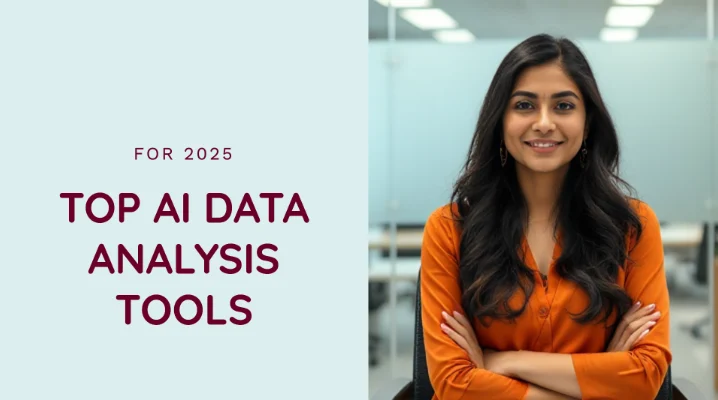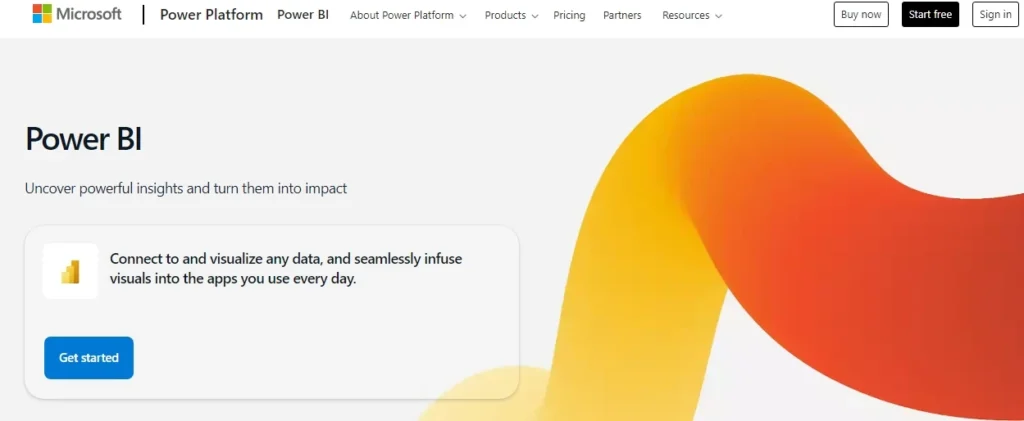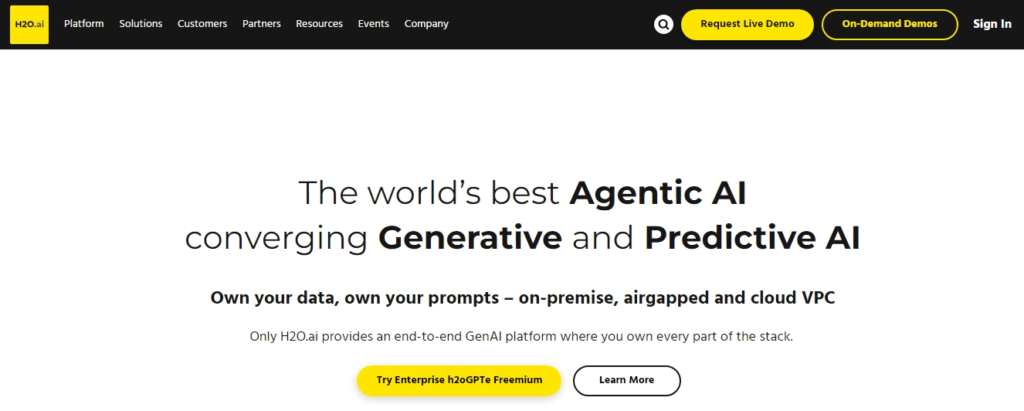Artificial intelligence has completely transformed data analysis, enabling businesses to uncover hidden patterns, automate complex tasks, and derive actionable insights with unprecedented accuracy. As businesses deal with increasingly complex datasets, advanced AI tools have become indispensable. Here, we present the top 7 AI data analysis tools for 2025 that stand out for their capabilities and user-friendly features.

Table of Contents
- Microsoft Power BI – A Leading AI Data Analysis Tool
- Tableau – Best AI Tool for Data Visualization
- KNIME – An Open-Source AI Data Analysis Tool
- Google Cloud AutoML – AI Tool for Scalable Data Analysis
- H2O.ai – Best AI Tool for Predictive Analytics
- IBM Watson Analytics – AI Data Analysis for Businesses
- DataRobot – Accelerating AI Data Analysis
- Frequently Asked Questions (FAQs)
- Conclusion
1. Microsoft Power BI – A Leading AI Data Analysis Tool
Microsoft Power BI is a robust business intelligence platform that allows users to visualize data, create reports, and develop dashboards seamlessly. It integrates with a wide range of data sources and offers advanced AI features such as natural language processing and predictive analytics, making it a preferred choice for professionals.

Key Features:
- Intuitive drag-and-drop interface for creating visualizations.
- Integration with Azure Machine Learning for advanced analytics.
- AI-driven insights to identify trends and anomalies.
Pricing:
- Free: Create interactive reports; upgrade to Pro or Premium for sharing.
- Power BI Pro: $10/user/month – Publish and share reports.
- Power BI Premium Per User: $20/user/month – Enterprise-scale features.
- Power BI Embedded: Variable pricing, contact sales.
2. Tableau – Best AI Tool for Data Visualization
Tableau is renowned for its powerful data visualization capabilities. It provides dynamic dashboards and allows users to interact with data without requiring coding expertise. Its AI-powered features enable businesses to uncover insights quickly and intuitively.

Key Features:
- Customizable, user-friendly dashboards.
- Real-time data collaboration and sharing.
- AI-driven features like “Ask Data” for natural language queries.
3. KNIME – An Open-Source AI Data Analysis Tool
KNIME (Konstanz Information Miner) is an open-source platform that excels in data preparation, machine learning, and visualization. It is a favorite among data scientists for its flexibility and compatibility with various programming languages and tools.

Key Features:
- Workflow-based interface for designing data analysis pipelines.
- Extensive library of pre-built nodes for data transformation and modeling.
- Supports integration with Python, R, and other programming languages.
Pricing:
- Personal Plan: Free – Access workflows and collaborate with the community.
- Team Plan: Starting at $99/month – Collaborate in private spaces.
- KNIME Business Hub Basic: $39,900/year – For small teams with business needs.
- KNIME Business Hub Standard: $71,250/year – For multiple teams, with advanced permissions and scalability.
- Enterprise Plan: Pricing available upon request.
4. Google Cloud AutoML – AI Tool for Scalable Data Analysis
Google Cloud AutoML is a suite of machine learning tools designed for users with varying levels of expertise. It simplifies the process of building custom machine learning models, making it an excellent choice for businesses looking to leverage AI without requiring deep technical skills.
Key Features:
- Intuitive interface for developing machine learning models.
- Scalability for handling large datasets.
- Integration with other Google Cloud services for a comprehensive solution.
5. H2O.ai – Best AI Tool for Predictive Analytics
H2O.ai is an open-source platform specializing in predictive analytics and automated machine learning. It offers scalability and advanced AI capabilities, making it a powerful tool for businesses handling extensive datasets.

Key Features:
- Automated machine learning for rapid model development.
- Scalability for processing large volumes of data.
- User-friendly tools for both technical and non-technical users.
6. IBM Watson Analytics – AI Data Analysis for Businesses
IBM Watson Analytics provides robust data mining and predictive analytics capabilities. It simplifies data exploration with its AI-driven insights and supports natural language processing for intuitive interaction with data.
Key Features:
- Automated pattern detection and trend analysis.
- Natural language query capabilities for ease of use.
- Cloud-based platform with extensive data visualization options.
7. DataRobot – Accelerating AI Data Analysis
DataRobot accelerates the machine learning workflow with its automated capabilities. It empowers businesses to develop and deploy AI models efficiently, supporting a wide range of industries and use cases.
Key Features:
- Automated machine learning for rapid insights.
- Compatibility with public clouds, data centers, and edge environments.
- Powerful tools for managing and optimizing machine learning models.
Frequently Asked Questions (FAQs)
1. What is the best AI tool for data analysis?
The best tool depends on your specific needs, but Microsoft Power BI, Tableau, and DataRobot are widely regarded for their advanced capabilities and ease of use.
2. Can AI tools handle large datasets efficiently?
Yes, tools like Google Cloud AutoML and H2O.ai are specifically designed to handle large datasets and provide scalable solutions.
3. Are there free AI data analysis tools available?
Yes, platforms like KNIME and H2O.ai offer free versions with robust features suitable for various data analysis tasks.
4. What is the role of AI in data visualization?
AI enhances data visualization by automating the creation of charts, dashboards, and trends, as seen in tools like Tableau and Microsoft Power BI.
5. How do AI tools improve decision-making?
AI tools analyze complex datasets to uncover patterns and provide predictive insights, enabling more informed and accurate decision-making.
6. Do I need coding skills to use AI tools?
Many tools, like Tableau and Google Cloud AutoML, are designed for users without coding expertise, offering intuitive interfaces and pre-built models.
7. How secure are AI data analysis tools?
Leading platforms like IBM Watson Analytics and Microsoft Power BI adhere to strict security protocols to ensure data privacy and compliance.
8. Can AI tools integrate with existing systems?
Yes, most AI tools provide seamless integration with existing systems, including CRMs, databases, and cloud services.
9. What industries benefit the most from AI data analysis tools?
Industries such as finance, healthcare, retail, and manufacturing benefit significantly from AI data analysis for improving operations and decision-making.
10. How can businesses choose the right AI tool?
Businesses should evaluate their data complexity, required features, scalability, and budget to select the most suitable AI tool.
Conclusion
Selecting the right AI data analysis tool depends on your organization’s specific needs, such as the complexity of your datasets, desired level of automation, and integration requirements. The tools highlighted above are among the best AI data analysis tools for 2025, each offering unique features to enhance data-driven decision-making.
By adopting these advanced tools, organizations can streamline their data analysis processes, uncover actionable insights, and maintain a competitive edge in their respective industries.